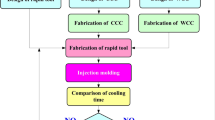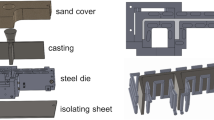Abstract
This study compares the thermal performances of a permanent metal mold with a conventional [pass-through cooling channel design and one with a new additively manufactured cooling channel design by investigating them both numerically and experimentally. While the conventional cooling channel metal mold was manufactured by the traditional pass-through drilled channel method, the new cooling channel metal mold was made via additive manufacturing. After the molten metal (Al6061 aluminum alloy) was poured into the mold, the temperature distribution and solidification rates of the product (valve) obtained from the metal molds were analyzed comparatively with the data taken from the inner surface of the mold in 0.5 s time steps. On the basis of temperature values on the molten side of the metal molds, it was calculated that the heat transfer rate away from the molten metal achieved by the new cooling channel design was approximately 48% higher than the conventional cooling channel. In addition, it was observed that the conventional cooling channel needed 21% more time to transfer heat away compared to the new cooling channel design.












Similar content being viewed by others
Abbreviations
- \({\dot{m}}\) :
-
Mass flow rate (kg/s)
- c p :
-
Specific heat capacity (J/kg∙K)
- \({\dot{Q}}\) :
-
Heat transferred (W)
- α :
-
Thermal diffusivity (m2/s)
- ρ :
-
Density (kg/m3)
- k :
-
Thermal conductivity (W/m K)
- T :
-
Temperature (K)
References
P. Amend, C. Pscherer, T. Rechtenwald, T. Frick, M. Schmidt, A fast and flexible method for manufacturing 3D molded interconnect devices by the use of a rapid prototyping technology. Phys. Procedia 5, 561–572 (2010)
S. Thomas, The Development of Design Rules for Selective Laser Melting (Cardiff Metropolitan University, 2009), https://repository.cardiffmet.ac.uk/dspace/handle/10369/913. Available 12 Aug 2015
A. Eleonora, A. Salmi, Study on unsupported overhangs of AlSi10Mg parts processed by direct metal laser sintering. J. Manuf. Process. (2015). https://doi.org/10.1016/j.jmapro.2015.04.004
P. Hanzl, M. Zetek, T. Baksa, T. Kroupa, The influence of processing parameters on the mechanical properties of SLM parts. Procedia Eng. 100, 1405–1413 (2015)
M. Ayabe, T. Nagaoka, K. Shibata et al., Effect of high thermal conductivity die steel in aluminum casting. Int. Metalcast. 2, 47–55 (2008). https://doi.org/10.1007/BF03355427
W. Kasprzak, M. Sahoo, J. Sokolowski, H. Yamagata, H. Kurita, The effect of the melt temperature and the cooling rate on the microstructure of the Al-20% Si alloy used for monolithic engine blocks. Int. J. Metalcast. 3(3), 55–71 (2009). https://doi.org/10.1007/BF03355453
S. Müller, A. Müller, F. Rothe et al., An initial study of a lightweight die casting die using a modular design approach. Int. Metalcast. 12, 870–883 (2018). https://doi.org/10.1007/s40962-018-0218-3
D. Neff, B.L. Ferguson, D. Londrico et al., Analysis of permanent mold distortion in aluminum casting. Int. Metalcast. 14, 3–11 (2020). https://doi.org/10.1007/s40962-019-00337-w
N. Ahammed, L.G. Asirvatham, S. Wongwises, Thermoelectric cooling of electronic devices with nano fluid in a multiport mini channel heat exchanger. Exp. Therm. Fluid Sci. 74, 81–90 (2016)
M. Al-Asadi, F.S. Alkasmoul, M.C.T. Wilson, Heat transfer enhancement in a micro-channel cooling system using cylindrical vortex generators. Int. Com-mun. Heat Mass Transf. 74, 40–47 (2016). https://doi.org/10.1016/j.icheatmasstransfer.2016.03.002
K.M. Au, K.M. Yu, W.K. Chiu, Visibility based conformal cooling channel generation for rapid tooling. Comput. Aided Des. 43, 356–373 (2011)
K. Prabhu, K. Sharath, G. Ramesh, Heat flux transients and casting surface macro-profile during downward solidification of Al-12% Si alloy against chills. Int. Metalcast. 5, 63–70 (2011). https://doi.org/10.1007/BF03355523
D. Singh, V. Navaneeth, J. Lee, Developing a localized squeeze cooling technique for improved casting solidification. Int. Metalcast. 5, 65–79 (2011). https://doi.org/10.1007/BF03355472
D. Sui, Z. Cui, R. Wang, S. Hao, Q. Han, Effect of cooling process on porosity in the aluminum alloy automotive wheel during low-pressure die casting. Int. J. Metalcast. 10(1), 32–42 (2015). https://doi.org/10.1007/s40962-015-0008-0
Y. Tian, D. Yang, M. Jiang et al., Accurate simulation of complex temperature field in counter-pressure casting process using A356 aluminum alloy. Int. Metalcast. (2020). https://doi.org/10.1007/s40962-020-00456-9
Y. Wang, K.M. Yu, C.C.L. Wang, Spiral and conformal cooling in plastic injection molding. Comput. Aided Des. 63, 1–11 (2015). https://doi.org/10.1016/j.cad.2014.11.012
C. Xia, F. Fu, J. Lai, X. Yao, Z. Chen, Conjugate heat transfer in fractal tree-like channels network heat sink for high-speed motorized spindle cooling. Appl. Therm. Eng. 90, 1032–1042 (2015). https://doi.org/10.1016/j.applthermaleng.2015.07.024
P. Hu, B. He, L. Ying, Numerical investigation on cooling performance of hot stamping tool with various channel designs. Appl. Therm. Eng. 96, 338–351 (2016). https://doi.org/10.1016/j.applthermaleng.2015.10.154
K. Eimsa-ard, K. Wannisorn, Conformal bubbler cooling for molds by metal deposition process. Comput. Aided Des. 69, 126–133 (2015). https://doi.org/10.1016/j.cad.2015.04.004
F. Du, X. Wang, Y. Liu, T. Li, M. Yao, Analysis of non-uniform mechanical behavior for a continuous casting mold based on heat flux from inverse problem. J. Iron Steel Res. 23(2), 83–91 (2016)
T. Vossel, N. Wolff, B. Pustal et al., Influence of die temperature control on solidification and the casting process. Int. Metalcast. 14, 907–925 (2020). https://doi.org/10.1007/s40962-019-00391-4
E. Sachs, E. Wylonis, S. Allen, M. Cima, H. Guo, Production of injection molding tooling with confor-mal cooling channels using the three dimensional printing process. Polim. Eng. Sci. 40(5), 1232–1247 (2000). https://doi.org/10.1002/pen.11251
A.S. Haselhuhn, P.G. Sanders, J.M. Pearce, Hypoeutectic aluminum-silicon alloy development for GMAW-based 3-D printing using wedge castings. Int. Metalcast. 11, 843–856 (2017). https://doi.org/10.1007/s40962-017-0133-z
M.M. Shehata, S. El-Hadad, M.E. Moussa et al., Optimizing the pouring temperature for semisolid casting of a hypereutectic Al–Si alloy using the cooling slope plate method. Int. Metalcast. (2020). https://doi.org/10.1007/s40962-020-00465-8
Z.H. Wang, J. Wang, L.B. Yu et al., Numerical simulation and process optimization of vacuum investment casting for Be–Al alloys. Int. Metalcast. 13, 74–81 (2019). https://doi.org/10.1007/s40962-018-0228-1
A. Hamasaiid, M.S. Dargusch, G. Dour, The impact of the casting thickness on the interfacial heat transfer and solidification of the casting during permanent mold casting of an A356 alloy. J. Manuf. Process. 47, 229–237 (2019)
W. Fang, X. He, R. Zhang, S. Yang, X. Qu, Evolution of stresses in metal injection molding parts during sintering. Trans. Nonferr. Met. Soc. China 25, 552–558 (2015)
R. Hölker, M. Haase, N.B. Khalifa, A.E. Takkaya, Hot extrusion dies with conformal cooling channels produced by additive manufacturing, In Aluminum Two Thousand World Congress and International Conference on Extrusion and Benchmark ICEB 2015 (2015), pp. 4838–4846. https://doi.org/10.1016/j.matpr.2015.10.028
F.Y. Hsu, P.S. Chen, H.J. Lin et al., Boiling phenomena of cooling water in the permanent mold. Int. Metalcast. 9, 31–40 (2015). https://doi.org/10.1007/BF03355613
J.I. Cho, C.W. Kim, The Relationship between dendrite arm spacing and cooling rate of Al–Si casting alloys in high pressure die casting. Int. Metalcast. 8, 49–55 (2014). https://doi.org/10.1007/BF03355571
A. Long, D. Thornhill, C. Armstrong et al., Stress correlation between instrumentation and simulation analysis of the die for high pressure die casting. Int. Metalcast. 7, 27–41 (2013). https://doi.org/10.1007/BF03355551
H. Yavuz, O. Ertugrul, Numerical analysis of the cooling system performance and effectiveness in aluminum low-pressure die casting. Int. Metalcast. (2020). https://doi.org/10.1007/s40962-020-00446-x
FLUENT Manual, Chapter 21: Modeling Solidification and Melting (ANSYS Inc, Canonsburg, 2001).
J.J. Valencia, P.N. Quested, Thermophysical properties, in ASM Handbook, vol. 15 (Casting ASM Handbook Committee, 2013), pp. 468–481. https://doi.org/10.1361/asmhba0005240
N. Akar, K. Boran, B. Hozikliğil, Kalıp Sıcaklığının Döküm Parça-Kalıp Arayüzey Isı Transfer Katsayısı Üzerine Etkisi. J. Fac. Eng. Arch. Gazi Univ. Cilt 28(2), 275–282 (2013)
S. Arankumar, K.V. Sreenivas Rao, T.S. Prasanna Kumar, Spatial variation of heat flux at the metal–mold interface due to mold filling effects in gravity die-casting. Int. J. Heat Mass Transf. 51(11), 2676–2685 (2008)
T.V. Christy, N. Murugan, S. Kumar, A Comparative study on the microstructures and mechanical properties of Al 6061 alloy and the MMC Al 6061/TiB2/12P. J. Miner. Mater. Charact. Eng. 9(1), 57–65 (2010)
R. Looser, M. Vivar, V. Everett, Spectral characterisation and long-term performance analysis of various commercial heat transfer fluids (HTF) as direct-absorption filters for CPV-T beam-splitting applications. Appl. Energy 113, 1496–1511 (2014)
C.P. Paul, P. Ganesh, S.K. Mishra, P. Bhargava, J.A. Negi, A.K. Nath, Investigating laser rapid manufacturing for Inconel-625 components. Opt. Laser Technol. 39(4), 800–805 (2007)
H. Sert, A. Can, H. Arıkan, B. Selcuk, H. Toprak, Wear behavior of different surface treated cam spindles. Wear 260(9–10), 1013–1019 (2006)
Author information
Authors and Affiliations
Corresponding author
Additional information
Publisher's Note
Springer Nature remains neutral with regard to jurisdictional claims in published maps and institutional affiliations.
Rights and permissions
About this article
Cite this article
Kan, M., Ipek, O. A Numerical and Experimental Investigation of the Thermal Behavior of a Permanent Metal Mold with a Conventional Cooling Channel and a New Cooling Channel Design. Inter Metalcast 16, 699–712 (2022). https://doi.org/10.1007/s40962-021-00633-4
Received:
Accepted:
Published:
Issue Date:
DOI: https://doi.org/10.1007/s40962-021-00633-4




